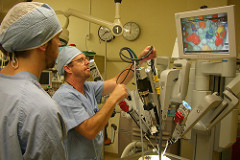With seven billion people in the world and counting, there are not enough skilled doctors around to perform emergency surgeries. Doctors can travel to patients for emergency surgeries, but traveling, especially at long distances, can cost a lot of time and money. However, there may be another option.
Teleoperated robots are remotely operated by humans through wires, a local wireless signal, the internet, and satellites. These robots make it possible for doctors to operate on nearly any patient in the world from a remote location, provided that the patient’s location has the robot. Having a robotic surgery, compared to having a conventional surgery, is actually advantageous in numerous ways. However, a recent study from the University of Washington in Seattle has evoked some security concerns pertaining to teleoperated surgical robots.
Let’s start with what robotic surgeries are, and the possible benefits of having one. A robotic surgery is not what you might think: a robot following a program and autonomously performing a surgery. This might be possible in the far future, but as of today, robotic surgeries are surgeries that are indirectly performed by a doctor who controls various specialized, precise robotic arms equipped with different surgical tools. A significant benefit of performing a robotic surgery is the reduced risk of the patient getting an infection. This is because a robotic surgery is a minimally invasive surgery: surgeons perform the surgery with small incisions, and this also results in smaller, less noticeable scars. Some other benefits for patients include less pain and bleeding, and faster recovery time compared to traditional open surgery.
Image Source: Chassenet
In an attempt to disrupt a robotic surgery to determine its potential security concerns, Tamara Bonaci and a team of researchers from the University of Washington have figured out how to hijack a teleoperated surgical robot, the Raven II. The team connected a computer to the console (where the operator controls the robot), which then connected to the actual robot. The communication between the console and the robot takes place over open networks that nearly anyone can access, allowing the connection between the console and the robot to be vulnerable to hackers’ attacks.
With the objective of moving some rubber blocks around, the team used three main methods that disrupted the robot to keep it from functioning properly. The first method involved altering and/or deleting the operator’s commands to the robot, making the robot’s movements abrupt and harder to handle. For the second method, the team tweaked the actual aim of the commands, such as rotating the arms to a different degree than originally intended by the operator. The third method involved taking complete control over the robot. It was actually fairly easy to do this, since the robot connects with the console with a standard communications protocol (Interoperable Telesurgery Protocol) that is publicly accessible.
Robot assisted surgeries are advantageous, but this study has exposed the vulnerabilities of their overall security, bringing about doubts and concerns for using the robots. The simple solution is to just encrypt the signal between the control console and the robot, but this is, of course, easier said than done. Hopefully in the near future, the majority of these security issues will be resolved. Who knows? Maybe one day we’ll have independently operating robots that can accurately perform surgeries.
Feature Image Source: Da Vinci by David Stillman










